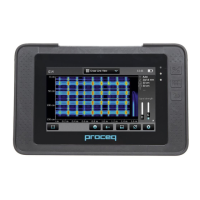© 2017 Proceq SA 34
Coated surfaces
It is not possible to make a measurement through an electrically isolating
coating (e.g. an epoxy resin coating, sealing sheets or asphalt layers.)
It is possible to make a measurement through thin dispersion coatings,
that are often used, for example on the walls and ceiling of underground
car parks, however this can cause a small shift of the potentials.
It is always necessary to check whether or not a measurement can be
made through a coating.
To do this, potentials should be measured at a few locations
• in the first place through the coating and
• with the coating removed
If possible, areas with largely varying potentials should be chosen. If
there is no alteration of the potential, or if a shift of the potential can be
compensated by a correction (e.g. V = ± 50 mV), then a measurement
can be made directly on the coating. If not, then the coating must be
removed before making the measurement.
Pre-moistening
The contact between the pore solution of the concrete and the probe can
be impaired by a dried out concrete skin. This can greatly increases the
electrical resisitivity of the concrete.
It is therefore recommended to moisten the surface approximately 10 to
20 minutes before carrying out the measurement.
If this is not possible, it must be ensured that the sponge on the Rod
Electrode or the felt hoops on the wheel electrode are sufficiently mois-
tened. In this case, when making a measurement, the probe must be held
against the surface until a stable end value is reached. (If the surface is
dry at the beginning of the measurement, it has to be moistened by the
sponge on the probe so a stable value will not be present initially.)
This is only possible with the Rod Electrode.
Proceq provides an additional sponge that connects to the rod electrode
in order to increase the overall surface contact area, to prevent testing
immediately above a large aggregate.
In the case of the wheel electrode with its continual automatic measure-
ment, it is not possible to monitor whether or not the measured value is
stable. Therefore it is recommended to pre-moisten the surface in sec-
tions and to measure in intervals of a few minutes.
4.2.2. Corrosion Settings
Enter Settings from the Main Menu (see “2.2 Main Menu”); scroll up and
down the screen by dragging your finger up or down the screen. The
current setting is displayed on the right hand side. Tap on an item to
modify it.
Measuring Mode
(Electrode)
Adjustable after
data storage
Settings Rod Wheel(s)
Probe Type
• •
No
Grid X Spacing
• •
No
Grid Y Spacing
• •
No
Enable Grid Limits
• •
No
Unit
• •
Yes
Measurement Path
•
No
Coarse Grid Factor
•
No
Auto Save
•
No
Direction of Next Line
• •
No
Potential Max Threshold
(Highest)
• •
Yes
Potential Min Threshold
(Lowest)
• •
Yes
Potential Range Palette
• •
Yes
Minimum Passive Limit
• •
Yes
Maximum Active Limit
• •
Yes
Half-cell Solution
• •
No

